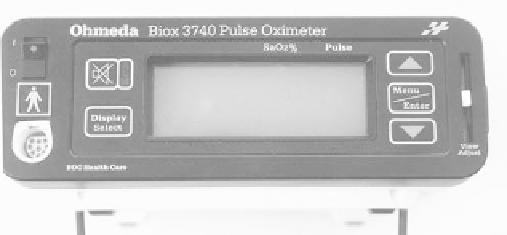Biomedical Engineering Reference
In-Depth Information
mentioned above, this should be in the inspiratory limb
after the check valve, but its location can vary depending
on machine vintage (
Figure 4.4-5
).
alarms indicate the possibility of an active vacuum in the
airway, or whether the patient is drawing a negative
pressure by fighting the ventilator.
Oxygen concentration
Monitoring
The ASTM standards require an oxygen concentration
measured in the inspiratory limb that turns on with the
machine and has a battery backup. Most utilize galvanic
fuel-cell technology, which involves a chemical reaction
between an electrolyte and two poles (anode and cath-
ode), similar to those of a battery. The reaction produces
an electrical potential relative to the oxygen concentra-
tion that is measured and displayed. It has a relatively
long time constant and cannot provide breath-to-breath
oxygen concentration.
Paramagnetic technology is incorporated in some CO
2
and agent monitors. It has a fast enough response to
overcome the limitation of galvanic fuel cells but is more
expensive. Using a switched magnetic field, it exploits
oxygen's natural magnetic properties to create a pressure
differential between gas streams (sample and reference),
which is detected and displayed as a concentration
(Ehrenwerth and Eisenkraft, 1993).
The American Society of Anesthesiologists (ASA) (ASA,
1998) has set minimum requirements for monitoring
during anesthesia. Depending on the patient's acuity and
other factors, such as the surgical procedure and anes-
thetic plan, the level of monitoring chosen by the anes-
thesiologist can exceed minimum requirements to
include invasive pressures (arterial, pulmonary artery,
and central venous), neuromuscular blockade, and
consciousness.
The first requirement of the ASA monitoring standard
is ''qualified anesthesia personnel.. '' The care provider
is ultimately the most important monitor and must be
able to concentrate on the patient without considerable
distraction. Secondarily, but no less significantly, the
standards specify monitoring for oxygenation, ventila-
tion, circulation, and temperature. Continuous physio-
logical monitoring is used during anesthesia, utilizing
plethysmographs, electrocardiograms (ECGs), and
oscillometric devices.
Figure 4.4-6
shows a pulse
oximeter used for monitoring the patient arterial blood-
oxygen saturation, Sa
4
O
2
.
Studies have shown that although a large percentage
of mishaps during anesthesia were due to human error,
a significant number were related to equipment failures
related to leaks, misconnects, gas-flow-control errors,
and circuit disconnects (Cooper
et al.
, 1984). Two of the
ventilation monitors (oxygen and volume) were
discussed previously. The ASA standard requires that
there be a device to detect a breathing-circuit disconnect
and that it must have an audible alarm. Along with the
use of pulse oximetry, the ASA specifies that there be
adequate lighting and exposure to assess patient color
and proper oxygenation. This serves as a reminder that
one cannot rely solely on monitors. Taking care of a
patient is ultimately the responsibility of the provider,
not of the monitor.
Volume measurements
Given the limitations of relatively simplistic volume-
controlled ventilators, volume measurement is the most
accurate device currently in use to provide users with
feedback of what tidal and minute volume is actually
delivered to the patient. Because of compliance of gas,
breathing circuit tubing, and additional dead space in the
circuit, the measurement is close, but not exact. A vane
anemometer measures a volume of gas by means of
monitoring the mechanical rotation of a vane or blade.
These devices can be either analog or digital. Technology
in newer machines includes ultrasound using Doppler
acoustical properties between two points to measure gas
flow. Hot wire systems measure energy requirements and
changes of a heated wire within a housing as gas volume
cools the surface. Pitot tubes in opposing directions
working in conjunction with differential pressure trans-
ducers are also used to measure flow.
Associated alarms
Many of these measurements are, primarily, a means to
inform the user of the possibility of a problem, such as
disconnect or leak. Oxygen monitors identify potential
hypoxic mixtures and catastrophic events and cannot
be set below 18% without alarming. Pressure alarms can
be used to indicate significant changes in the patient's
condition or restriction in the airway. Subatmospheric
Figure 4.4-6 Ohmeda Biox model 3740 pulse oximeter.










